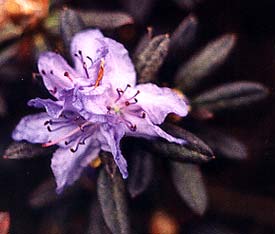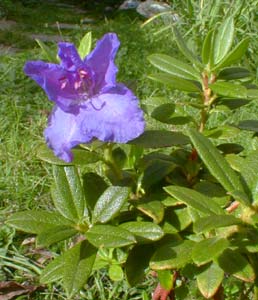 'Oceanlake' rhododendron
'Oceanlake' rhododendron
a dwarf with year-round charms
"Between the showers I went my way,
The glistening street was bright with flowers;
It seemed that March had turned to May
Between the showers."
-Amy Levy
(1861-1889)
(1861-1889)
It's nice to know the species origin of hybrid rhododendrons as that does say something about their habits, or reveals where they got their traits. But rhodies have been hybridized for over one hundred fifty years & sometimes their heritage is either unknown, or so mixed up it approaches the absurd.
The 'Oceanlake' cultivar is a case in point. Its parents were two cultivars, 'Blue Diamond' pollinated by 'Sapphire.' 'Blue Diamond' was already quite a mixed plant derived at least from R. intricatum, R. augustinii & R. fastiatum, whereas Sapphire began as 'Blue Tit' pollinated by R. impeditum. Blue Tit in turn had been a cross R. impeditum & R. augustinii. If any species comes dominant in all that it is R. impeditum, a groundcover rhody sometimes sold as a species plant under the name Cloudland, & brought into western gardening from Yunnan China by the great plant explorer George Forrest in 1911. You'll find a bit about George Forrest & his Chinese expeditions on the Rhododendron yungningense page.
But the main connecting thread between the hybridizers' various choices across the generations arriving at 'Oceanlake' is how all these lavender & pale purple rhodies held some promise of eventually achieving the color blue. If a purer blue was indeed the intent, it was not fully achieved, for Oceanlake is more of a violet-blue. But I find it as close to a really blue as violet can get. It's awfully pretty in any case & even seems to glow as with its own light. The flowers occur as four to six flat-faced funnels per truss, showy but not over-dressed for the occasion.
 A true dwarf, low-growing with dense foliage, it takes ten years to reach a scant three foot tall rounded mound. Some people "hedge" them slightly to make them a perfect dome, & the shrub doesn't mind, though I wouldn't do that to a plant or a poodle.
A true dwarf, low-growing with dense foliage, it takes ten years to reach a scant three foot tall rounded mound. Some people "hedge" them slightly to make them a perfect dome, & the shrub doesn't mind, though I wouldn't do that to a plant or a poodle.It has very small narrow evergreen leaves which are bright green when new, but turn a gorgeous darkest plum-color in winter & stays that color until late spring. When it blooms in May the purple-black winter color of the wee leaves is still very much present, as can be seen in the photo above.
Oceanlake like many rhodies is mildly toxic in its leaves & roots, a survival technique to repel insects. It is one of the rhodies that is most highly resistant to insect attack. Root weevils will crawl up on the leaves at night, desirous of chewing on the edges, only to discover the slippery leaves curl down around the edges, causing the the weevils to slide off. So the plant has two lines of defense against being chomped on, toxicity & leaf shape, hence it is rarely chomped.
It is cold-hardy to minus five F. It prefers loamy acidic soil but is forgiving of imperfect growing conditions, adapting to various soils & light exposures. Its dark leaf coloration is best if it is not set in too much shade, & it also blooms better with sunlight. But like nearly every other rhody, it is unforgiving of high winter winds, which can suck the shrub dry in time.
The flower close-up at the top of the page was snapped in May (2001), its usual time of blooming. The second photo, however, was shot in October (2003), when the shrub produced one flower out of season! This behavior is called "sporting" & doesn't often happen, though a group of delicate azaleas called "Encores" are bred specifically to enhance what in other azaleas happens only rarely. 'Oceanlake' nearly died during a record drought, & had to be brutally cut back to the living portion. Near Autumn it put on a burst of new leaf growth, & produced the one flower, which it probably wouldn't have done if it hadn't been recovering from extreme stress.
In essence something occurs in its environment that tricks such a shrub into believing autumn is spring, & the buds it produced earlier in the year break from dormancy prematurely. Occasionally such an azalea will produce quite a lot of flowers for Autumn, but this is only partially a boon, as means the shrub will have that many fewer buds to open come Spring.
Other shrubs growing nearby include the azaleas 'Girard's Crimson,' & 'Youth.' In autumn 2004 we added twenty bulbs of the small 'Valerie Finnis' grape hyacinths to the front of this garden with 'Oceanlake" behind them.